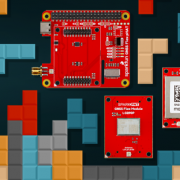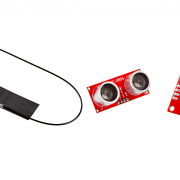DIY LED Motorcycle Helmet
Instead of buying expensive, one-color LED kits to attach to your helmet, use SparkFun addressable LEDs!
It's strange to be in front of the camera for once, since I'm typically behind it filming engineers create and present awesome projects (I was pretty thrilled to make myself an official SparkFun lower third motion graphic!). I'm an avid motorcycle rider and I ride to SparkFun every morning if the weather is nice (Colorado is known for its inconsistency). One of the most prominent dangers of riding a motorcycle is not being seen by other drivers, which is a constant concern, especially at night.
With by backup helmet collecting dust, I decided to create an LED motorcycle helmet using SparkFun parts so cars would unmistakably see me on the road. They honestly might be too bright and distracting for some, but it definitely does the job.
The best part about this project was that you can adjust it to whatever you want. Put it on a bicycle helmet, change the colors or add more hardware to make them react to specific movements or speeds. The opportunities are endless.
Here is a list of all the things you will need to build this:
- Helmet of any kind
- LED RGB Addressable Strip
- Qduino Mini
- LiPo Battery
- LiPo Charger
- String or thread
- Tape
- Hot Glue
- Soldering kit
- Wire
- Velcro tabs
Here are the steps to create the one I made:
1. Plan out your LED design with string and tape (make sure you have a good place to hide the electronics!)
2. Cut the LED roll into strips to fit the helmet (make sure they are all in the right direction to make a circuit)
3. Stick the LED strips onto the helmet - they are sticky enough to stay on at least temporarily
4. Cut open the plastic at the end of the strips to expose the leads you need to solder
5. Solder all the LED strips together (this may take some time, so get comfortable)
6. Solder the Qduino Mini to the end of the LED circuit
- GND - GND
- Din - D8
- 5V - VCC
7. Count the number of LEDs and program the Qduino Mini
8. Test with a LiPo Battery
9. Insulate all solder joints with hot glue, as well as any wires that might be exposed if their plastic casing melted off while soldering
10. Optional: If the LED strips don’t stick onto your helmet as well as you’d like, you can either hot glue them or use an adhesive to make sure they won’t come off while riding
11. Use Velcro to add the Qduino Mini and LiPo battery to the inside of your helmet
12. Plug in, turn on and ride off in style!
With Feldi literally showing me how to solder and program for the first time, I created exactly what I wanted. The project turned out to be almost half the price of LED helmet kits available for purchase online and I have the opportunity to change the colors and sequence. I wore my LED helmet and Feldi’s DIY LED Sneakers out riding at night and became a bright, colorful light that drivers saw immediately.
(I'm a competitive parkour athlete and when I was in college, I had a theme that every video I submitted for a project had to somehow involve a flip. So I continued that tradition with this video after the START SOMETHING outro. Hope you enjoyed the video as much as I enjoyed creating it!)
Interested in learning more about LEDs?
See our LED page for everything you need to know to start using these components in your project.








